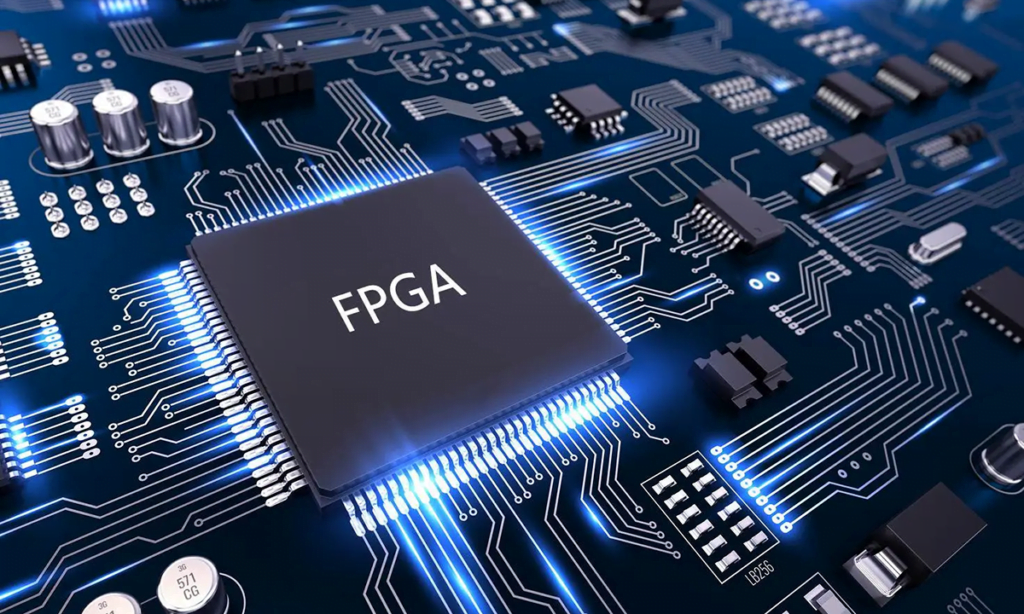The Field Programmable Gate Array (FPGA) market is witnessing a transformative shift as the demand for customizable, high-performance, and power-efficient computing solutions rises. FPGAs are integrated circuits designed to be configured by the end user after manufacturing, offering unmatched flexibility and performance benefits across a broad range of applications.
Once considered niche components, FPGAs have now become critical to industries such as telecommunications, automotive, consumer electronics, aerospace, defense, healthcare, and data centers. Their ability to deliver parallel processing, low latency, and reconfigurable logic has made them essential in applications ranging from AI acceleration and 5G deployment to edge computing and high-frequency trading.

What Is an FPGA?
A Field Programmable Gate Array is a type of semiconductor device that contains an array of programmable logic blocks and interconnects. Users can configure the hardware functionality post-manufacturing, which allows for tailored performance, faster prototyping, and adaptive responses to changing system needs.
Unlike traditional ASICs (Application-Specific Integrated Circuits), FPGAs can be reprogrammed multiple times, making them ideal for systems that require hardware-level adaptability and fast iteration cycles.
Key Market Drivers
1. Growth of AI, Machine Learning, and Deep Learning
FPGAs provide parallel processing capabilities and low power consumption, making them suitable for real-time AI workloads, edge inferencing, and neural network acceleration. Their reconfigurability allows developers to optimize architectures as AI models evolve.
2. Deployment of 5G Networks
The demand for low-latency, high-throughput communication infrastructure has boosted the adoption of FPGAs in 5G base stations and core networks. Their ability to adapt to changing protocols and standards is critical in the rapidly evolving telecom space.
3. Increasing Use in Automotive and ADAS
As the automotive sector transitions to electric and autonomous vehicles, the need for advanced processing units that can handle sensor fusion, vision systems, and real-time data processing is growing. FPGAs enable these functionalities with the added benefit of safety and reliability.
4. Data Center and Cloud Computing Applications
FPGAs are increasingly deployed in data centers for workload acceleration, encryption, compression, and deep packet inspection. Cloud providers are leveraging them to improve performance per watt and enable flexible computing environments.
5. Aerospace and Defense Requirements
The rugged and mission-critical nature of aerospace and defense systems makes FPGAs an optimal choice. Their reprogrammability and resistance to obsolescence offer long-term value and operational reliability in harsh conditions.
Market Segmentation
The Field Programmable Gate Array (FPGA) market is segmented based on technology, configuration, application, and region.
By Technology:
SRAM-Based
Antifuse-Based
Flash-Based
By Configuration:
Low-End FPGA
Mid-Range FPGA
High-End FPGA
By Application:
Telecommunications
Automotive
Industrial
Military and Aerospace
Consumer Electronics
Medical Devices
Data Centers
By Geography:
North America
Europe
Asia-Pacific
Latin America
Middle East & Africa
Regional Outlook
North America
North America dominates the FPGA market due to strong demand from defense, data center, and telecom sectors. Major players like Intel (Altera) and Xilinx have a significant presence in the region.
Europe
Europe is witnessing stable growth, driven by its automotive and industrial automation sectors. Germany and the UK are investing heavily in semiconductor innovations.
Asia-Pacific
Asia-Pacific is the fastest-growing region in the FPGA market, led by countries like China, Japan, South Korea, and Taiwan. The region’s large electronics manufacturing base and 5G infrastructure projects are key drivers.
Latin America and MEA
Emerging applications in smart cities, energy, and defense are contributing to FPGA demand in these regions, though growth is at a moderate pace compared to others.
Competitive Landscape
Key players in the Field Programmable Gate Array (FPGA) market include:
Intel Corporation (Altera)
AMD (Xilinx)
Lattice Semiconductor
Microchip Technology Inc.
QuickLogic Corporation
Achronix Semiconductor Corporation
Efinix Inc.
Flex Logix Technologies
These companies are focused on innovations in low-power design, AI/ML acceleration, and 7nm/10nm fabrication technologies to meet the performance demands of next-generation applications.
Challenges in the FPGA Market
While the market is poised for strong growth, several challenges need to be addressed:
Complexity in Programming: FPGA design requires specialized knowledge in hardware description languages (HDLs), which can limit widespread adoption.
Higher Cost than ASICs (for large volumes): While FPGAs are ideal for low- to mid-volume production, they can be more expensive per unit than ASICs for large-scale deployments.
Power Consumption in High-End Applications: Some high-end FPGAs may consume more power compared to fixed-function chips, which can be a concern in mobile or edge devices.
Longer Time-to-Market Without Prebuilt IP: Lack of pre-designed intellectual property blocks can delay product development in time-sensitive projects.
Future Outlook
The future of the Field Programmable Gate Array (FPGA) market is tightly linked to trends such as:
Increasing demand for adaptive hardware in edge and AI computing
More accessible development tools and low-code environments
Integration with CPUs and SoCs for hybrid solutions
Expansion of FPGA-as-a-Service (FaaS) in cloud platforms
Rising investments in semiconductor R&D and foundry services
With continued innovation and broader adoption, FPGAs are expected to play a central role in enabling real-time, adaptive, and efficient processing across diverse industries.
Conclusion
The Field Programmable Gate Array (FPGA) market is evolving rapidly, driven by the increasing need for hardware acceleration, low-latency computing, and flexible logic implementation. Whether powering autonomous vehicles, enabling 5G networks, or accelerating AI models in data centers, FPGAs are becoming indispensable in the modern computing landscape.
As industries continue to demand performance, agility, and scalability, the FPGA market is set to grow in both value and influence, making it a key area of focus for technology providers, developers, and enterprises worldwide.
Related Trending Reports
| Energy Management System Market |
| Document Management System Market |
| 3D Printing Market |
| Optical Transceiver Market |
| Micro-LED Display Market |